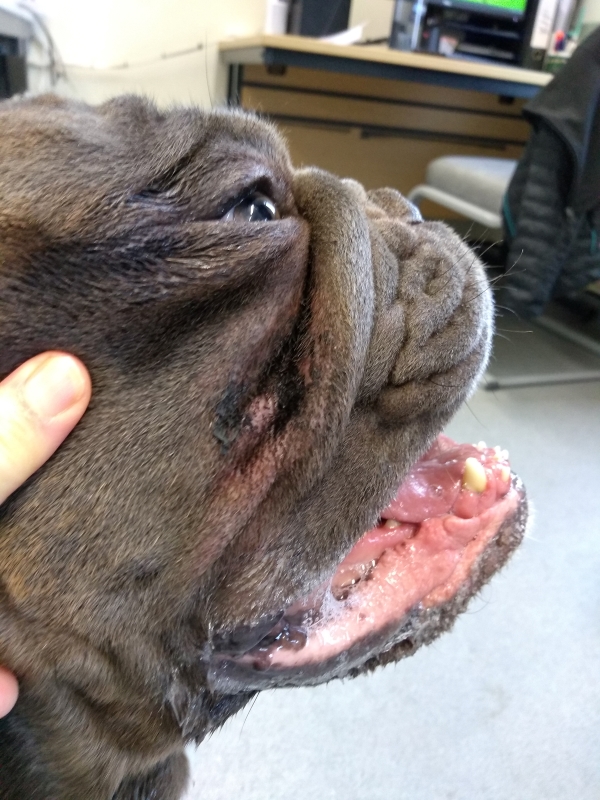Beauty isn’t even skin deep: New study from the RVC finds that flat-faced dogs are at the highest risk of skin fold dermatitis
New research from the Royal Veterinary College (RVC) has found that some popular flat-faced dog breeds, including the English Bulldog, French Bulldog and Pug, are at the highest risk of skin fold dermatitis – a painful skin condition. The study highlights that although folded skin on dogs may seem ‘cute’ to many humans, it can have high health and welfare implications for affected breeds.
Skin fold dermatitis is caused by friction, excessive moisture and lack of ventilation deep in folds of skin. It ranges from reddened to infected and ulcerated skin that has a bad smell and often results in pain throughout a dog’s life. The impact of the condition on canine welfare has risen over the past decade due to dramatically rising worldwide popularity of some flat-faced dog breeds (which often exhibit deep facial folds). Other factors such as obesity and chronic skin disease can also predispose to skin fold dermatitis.

The study, by the RVC’s VetCompass Programme, included more than 900,000 dogs from the general pet dog population under veterinary care in the UK. Anonymised veterinary clinical records were searched for diagnoses of skin fold dermatitis within a single year. The results showed that a formal diagnosis of skin fold dermatitis was recorded in one in 300 of all dogs each year (0.37% of dogs diagnosed annually). However, certain breeds showed much higher levels of the condition.
The study found that the breeds with the highest proportion of skin fold dermatitis diagnoses each year were English Bulldog (6.1%); French Bulldog (2.7%) and Pug (2.1%). Overall, 1.0% of all flat-faced (brachycephalic) dogs were affected compared to just 0.3% of dogs with the typical medium-length skull. Breeds that typically show pronounced skin folds on the face or body were between 11-49 times more likely to suffer from the condition than crossbreed dogs. Purebred dogs had an increased risk (x2.5) of skin fold dermatitis compared to crossbred dogs.
The most common locations on the dog’s body for skin fold dermatitis were the lip (36.8%); facial folds (22.0%); vulva (14.2%); nasal fold (9%); tail (5.8%) and periocular fold (surrounding the eyeball) (3.5%); and the most common clinical signs recorded were reddened skin (34.2%), inflammation (24.2%), moistness (20.6%), malodour (18.6%) and pain (18.0%).
Additional key findings include:
- The breeds with the highest percentage of dogs affected with skin fold dermatitis were English Bulldog (6.1%), French Bulldog (2.7%), Pug (2.1%), Basset Hound (2.0%), Cocker Spaniel (1.3%), Shar-Pei (0.9%), Cavalier King Charles Spaniel (0.9%) and Boxer (0.9%).
- The breeds with the highest predisposition (compared to cross bred dogs) for skin fold dermatitis were English Bulldog (x49.1 times risk), French Bulldog (x25.9), Pug (x16.3), Basset Hound (x10.7), Cocker Spaniel (x7.5), Shar Pei (x6.4), Boxer (x4.6) and Cavalier King Charles Spaniel (x4.5).
- The most protected breeds that had at least one case of skin fold dermatitis were Yorkshire Terrier (x0.1), Border Collie (x0.3) Jack Russell Terrier (x0.5) and Labrador Retriever (0.6).
- The three breeds with extreme flat faces (brachycephaly) (English Bulldog, French Bulldog and Pug) showed high levels of facial, nasal, and periocular locations. In contrast, the lips were the dominant location in the spaniel breeds (Cocker Spaniel and Cavalier King Charles Spaniel) and the West Highland White Terrier.
- The risk of diagnosis with skin fold dermatitis rose as dogs aged.
- Pain was recorded in nearly one in five dogs that had a record of clinical signs of skin fold dermatitis.
Dr Dan O’Neill, lead author of the paper and Associate Professor in Companion Animal Epidemiology at the RVC said:
“As humans, we hold the power to ensure that every pet dog starts life with good natural health. When choosing which dog to own, this means selecting a breed that does not have extreme conformations such as folded skin which can lead to a lifetime of painful skin infections.
“This study adds to the growing evidence of the substantial harms that extreme body shapes can have on our dog’s health and will hopefully encourage prospective owners to ‘stop and think’ about avoiding extreme body shapes before choosing which breed to purchase.”
Dr Anke Hendricks, co-author and Associate Professor in Veterinary Dermatology at the RVC, said:
“Skin fold dermatitis is a common problem in dogs with skin folds or pockets. It is not always easy to spot where folds are deep, nor is it necessarily recorded in the health records, and as such this study is likely to underestimate the problem. Prevention or treatment of infection requires very frequent skin care or medication throughout a dog’s life and adds a considerable care burden and cost to living with an affected dog.”
Bill Lambert, Health, Welfare and Breeder Services Executive at The Kennel Club, said:
“Skin fold dermatitis is a serious condition and although this research, funded in part by The Kennel Club Charitable Trust, found that only 0.37% of dogs, and 1% of flat-faced dogs, were affected, it’s likely that some owners don’t recognise the signs to look out for and may not seek treatment. This is an important reminder that owners of dogs with wrinkles should be aware of the potential problems and know how to avoid them – by cleaning their dog’s skin folds daily, ensuring they’re kept dry and making sure their dog is not overweight.
“It is also vital that people make informed puppy buying choices and avoid those dogs that are bred for extreme wrinkles – which are far removed from what’s described in breed standards – and instead ‘stop and think’, and find a responsible breeder, who has their dogs' welfare at heart.”
Dr Laura Hamilton, veterinary surgeon and Breed Health Coordinator UK French Bulldog Clubs, said:
“The French Bulldog Clubs and all those who care about these dogs, agree extreme exaggerations - like excessive skin folds - must be avoided, and are disappointed in the recent trend of rogue breeders producing increasingly extreme brachycephalic dogs, like Bulldogs, French Bulldogs, and Pugs, for profit.
“We have changed the breed standard to call for more moderation and continue to urge breeders to move away from over-wrinkling, to improve the health and welfare of French Bulldogs.
“We urge members of the public to do their research, speak to their local breed clubs and veterinary professionals, and stop and think before buying a flat faced dog. We would recommend the public to move towards purchasing dogs with less exaggerated skin folds and therefore less health and welfare issues relating to this exaggeration.”
Sonia Saxon, PR Representative, Bulldog Breed Council said:
“The Bulldog Breed Council work closely with the KC to educate and guide people to research and buy bulldogs from responsible breeders who use the tools available to health test and breed to the Bulldog Breed, standard which does not ask for any exaggerations.
“We also give advice on environmental factors that can affect any breed but we welcome any research that can help us protect the UKs National Breed.”
Cynthia Timbury, Pug Breed Council Secretary said:
“The six Pug Breed Clubs agree that extreme exaggeration in conformation within the breed should be avoided and this includes excessive skin folds. Over the last few years we have made good progress in eliminating these exaggerations from the show population.
“The latest Vet Compass paper has highlighted an area of concern within the Pug breed of skin issues frequently associated with exaggeration and also lack of knowledge by owners of appropriate care for a Pug.
“This data highlights the need to prioritise researching a breed and only sourcing a puppy from breeders who are actively involved in health screening, breeding to the Breed Standard, and “to stop and think before buying a flat face dog
“There is a wealth of breed specific knowledge within our breed clubs, websites and health schemes freely available to people considering adding a Pug to their family.”
Reference
Dan G. O’Neill, Dara Rowe, Dave C. Brodbelt, Camilla Pegram & Anke Hendricks (2022) “Ironing out the wrinkles and folds in the epidemiology of skin fold dermatitis in dog breeds in the UK”, Nature Scientific Reports
The full paper is available from 10am GMT Wednesday 6th July and can be accessed here: DOI: 10.1038/s41598-022-14483-5
Media enquiries
For media enquiries, please contact:
- Jasmin De Vivo jasmin.devivo@plmr.co.uk or rvc@plmr.co.uk
- Press Line: 0800 368 9520
About the RVC
- The Royal Veterinary College (RVC) is the UK's largest and longest established independent veterinary school and is a Member Institution of the University of London.
- It is one of the few veterinary schools in the world that hold accreditations from the RCVS in the UK (with reciprocal recognition from the AVBC for Australasia, the VCI for Ireland and the SAVC for South Africa), the EAEVE in the EU, and the AVMA in the USA and Canada.
- The RVC is ranked as the top veterinary school in the world in the QS World University Rankings by subject, 2022.
- The RVC offers undergraduate and postgraduate programmes in veterinary medicine, veterinary nursing and biological sciences.
- The RVC is a research led institution with 88% of its research rated as internationally excellent or world class in the Research Excellence Framework 2021.
- The RVC provides animal owners and the veterinary profession with access to expert veterinary care and advice through its teaching hospitals and first opinion practices in London and Hertfordshire.


.jpg?v=638497413140627706)